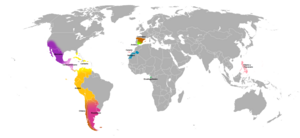
Back قائمة لهجات إسبانية Arabic Dialectologie de la langue espagnole French Dialectos do castelán Galician Spanyol nyelvjárások Hungarian Dialetti spagnoli Italian
This article should specify the language of its non-English content, using {{lang}}, {{transliteration}} for transliterated languages, and {{IPA}} for phonetic transcriptions, with an appropriate ISO 639 code. Wikipedia's multilingual support templates may also be used. (April 2021) |



In other colors, the extent of the other languages of Spain in the bilingual areas.




Some of the regional varieties of the Spanish language are quite divergent from one another, especially in pronunciation and vocabulary, and less so in grammar.
While all Spanish dialects adhere to approximately the same written standard, all spoken varieties differ from the written variety, to different degrees. There are differences between European Spanish (also called Peninsular Spanish) and the Spanish of the Americas, as well as many different dialect areas both within Spain and within the Americas. Chilean and Honduran Spanish have been identified by various linguists as the most divergent varieties.[1]
Prominent differences in pronunciation among dialects of Spanish include:
- the maintenance or lack of distinction between the phonemes /θ/ and /s/ (distinción vs. seseo and ceceo);
- the maintenance or loss of distinction between phonemes represented orthographically by ll and y (yeísmo);
- the maintenance of syllable-final [s] vs. its weakening to [h] (called aspiration, or more precisely debuccalization), or its loss; and
- the tendency, in areas of central Mexico and of the Andean highlands, to reduction (especially devoicing), or loss, of unstressed vowels, mainly when they are in contact with voiceless consonants.[2][3][4]
Among grammatical features, the most prominent variation among dialects is in the use of the second-person pronouns. In Hispanic America the only second-person plural pronoun, for both formal and informal treatment, is ustedes, while in most of Spain the informal second-person plural pronoun is vosotros with ustedes used only in the formal treatment. For the second-person singular familiar pronoun, some American dialects use tú (and its associated verb forms), while others use either vos (see voseo) or both tú and vos [citation needed] (which, together with usted, can make for a possible three-tiered distinction of formalities).
There are significant differences in vocabulary among regional varieties of Spanish, particularly in the domains of food products, everyday objects, and clothes; and many American varieties show considerable lexical influence from Native American languages.
- ^ Alemany, Luis (2021-11-30). "El español de Chile: la gran olla a presión del idioma". El Mundo (in Spanish). Retrieved 2022-06-01.
- ^ Cotton & Sharp (1988)
- ^ Lope Blanch (1972:222)
- ^ Delforge (2008)
